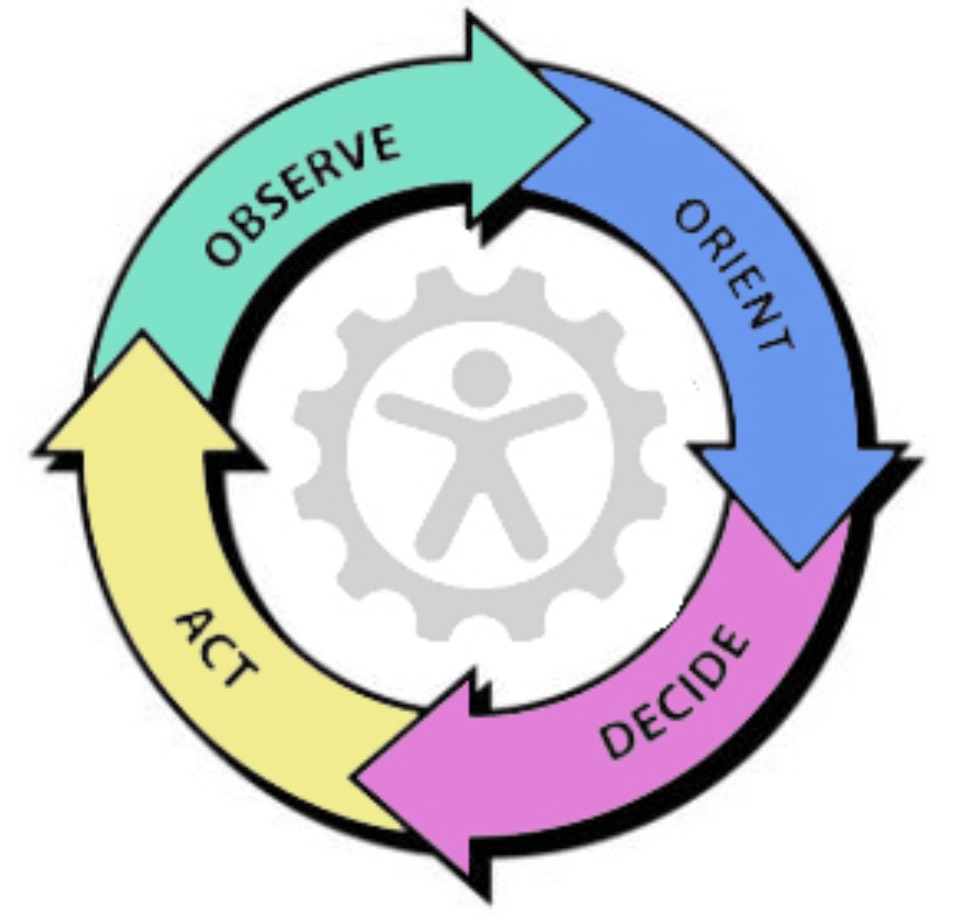OODA loop
Your strategy to make you more productive, competitive and profitable
If you are engaged in manufacturing, you very likely already know about Material resources planning (MRP), Enterprise resource planning (ERP), Manufacturing executions system (MES), Manufacturing operations management (MOM), Overall equipment efficiency (OEE), Key performance indicator (KPI) and other terms. But have you heard about OODA loop and its role in manufacturing?

OODA stands for “Observe, Orient, Decide, and Act.” It’s also known as the Boyd Cycle, named after the late US Air Force Colonel James Boyd, a former fighter pilot who created it as a strategy for gaining advantage over enemies in battle.
OODA stresses the need to observe data and events, determine the meaning, filter out the noise, reorient as new information comes in, and above all take action – all in a continuous loop.
In a tough market challenged by low operating margins, the ability to think and act more quickly gives your shop a distinct advantage. It helps to increase productivity, gain additional capacity, lower operational costs, become more competitive and ultimately make more profit.
There is no solution on the market which supports this philosophy better than ZOOMFAB. It addresses every step in OODA loop. And it differs to other solutions in simple fact that it focuses on information which is factual. There is nothing worse in any organization than when managers and employees become prisoners of their own views. Organization can only survive if it breaks through this impasse by adopting itself to reality. ZOOMFAB is a simple but extremely efficient tool allowing you to achieve just that.
Let’s look at how ZOOMFAB can apply the OODA philosophy within your digital factory, from insight to action.

1. Observe
ZOOMFAB uses advanced non-invasive sensors to collect data from your machines. Data is collected automatically and without the need for an operator’s input. This makes the data unambiguous and accurate. Received data is available in real-time on a monitoring dashboard in a meaningful, graphical and numerical format so the user can instantly understand the situation on the shop floor and single out in seconds, the problematic work centres or individual machines. ZOOMFAB literally provides a “Heads-Up Display” with a view on the whole battlefield…
2. Orient
Pretty graphs about your machine status on their own is not enough to make competent decisions. ZOOMFAB’s powerful analytics process incoming data into a variety of indicators, which the naked eye can’t see nor intuition can feel. They include: machine operational status, time when machine was switched ON, time it took to start first job, total time machine is switched ON, total time machine is operating, total time machine idles, energy consumed, machine elements used (laser or punch on combination machine, tool changing, pallet changing, conveyor system speed, powder-coat application, status of oven pre-heating or baking, etc.).
To reinforce this picture, ZOOMFAB also calculates generated revenue and profit/loss, composition of profit, projected annual revenue and profit, actual and budgeted machine utilization, value of consumed and wasted energy, etc. All this data is available for work centres and also individual machines, so the user has a very clear understanding where money is being made and where it is lost.
Finally, there is one more and probably the most important indicator to the user... ZOOMFAB calculates for each work centre an actual hourly rate and compares it with the budget. Which work centres are profitable and which one act as a charity??? Here you can see the importance of constantly keeping an eye on your business and ZOOMFAB is your early warning system.
3. Decide
Now you are armed for battle and with your personal knowledge and experience to make your decision. However, if you are still not sure, ZOOMFAB has in reserve two more tools.
The first tool shows machine utilization trends by day, week, month and year. Compare 90 day utilization average to your budget. Check individual daily graphs and evaluate machine reliability, unnecessary power consumption, power outages, operator habits and other issues which require immediate or short term attention.
The second tool, which is very unique for a manufacturing job shop, is called “What if?”. It allows the user to model various scenarios in the factory like removing and adding machinery, changing the length of working hours, improving machine utilization (productivity) and more. The user can see the effect of those changes on production capacity, revenue and profitability.
4. Action
As the last step in the OODA loop, the Action which can be taken to apply and implement the Decision. In this step, the user acts on a prioritized list of decisions. Once action is taken, experiences and consequences of the approach are forwarded to the first stage, the loop is completed and cycle starts over again for sustainable continuous improvement.
So when considering OODA loop philosophy, how does ZOOMFAB compare to a typical ERP/MES?
- ZOOMFAB collects machine utilization data automatically. Data is simple, adequate and accurate.
ERP/MES collect data from huge amounts of individual manufacturing operations. A large percentage of this data is entered manually by the operator, making it unreliable for serious calculations of machine utilization. - ZOOMFAB receives, processes and makes data available instantly. The process requires no human input or evaluation. Instant data availability allows user to take pro-active approach when solving problems.
ERP and MES require each other, otherwise none of them on their own, can produce comprehensive enough machine utilization data. Unfortunately, processing this data requires time, results are complex and often require additional evaluation. Data availability is substantially delayed, forcing the user to be reactive. - As a metal fabrication job shop has its budget based on selling machines and labor hours, ZOOMFAB basically evaluates your business performance by analyzing budgeted and actual machine utilization times.
ERP/MES calculates machine utilization through individual jobs. This approach is complicated and inaccurate. It produces distorted values, which hide actual utilization and capacity reserves. It is common to see in ERP daily machine utilization showing 7 hours of operation and 1 hour unallocated (idle), but independent monitoring clearly shows that the machine was operating only 5 hours and has 3 hours available capacity…
We use OODA loop in our ordinary life every day and it works. If this philosophy appeals to you, you should implement your best partner for it. ZOOMFAB. Because intuition is not enough.



